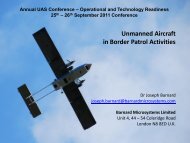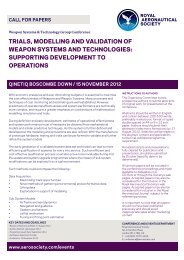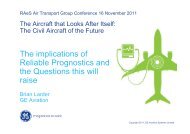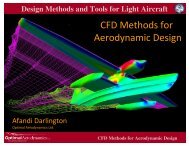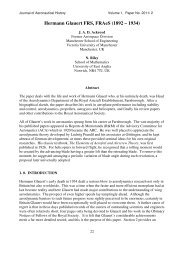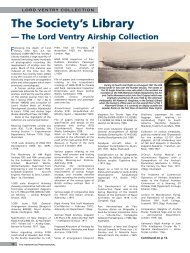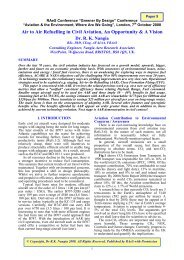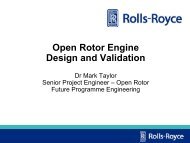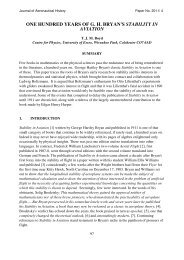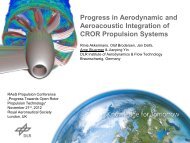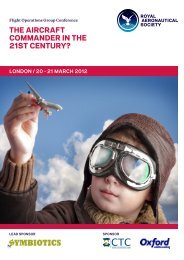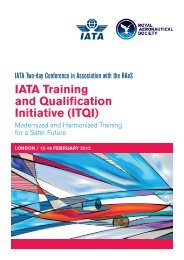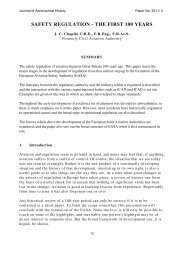Smoke, Fire and Fumes in Transport Aircraft - Royal Aeronautical ...
Smoke, Fire and Fumes in Transport Aircraft - Royal Aeronautical ...
Smoke, Fire and Fumes in Transport Aircraft - Royal Aeronautical ...
Create successful ePaper yourself
Turn your PDF publications into a flip-book with our unique Google optimized e-Paper software.
APPENDIX 3<br />
Do You Smell <strong>Smoke</strong>? Issues <strong>in</strong> the Design <strong>and</strong> Content of<br />
Checklists for <strong>Smoke</strong>, <strong>Fire</strong> <strong>and</strong> <strong>Fumes</strong><br />
Barbara K. Burian, PhD<br />
SJSU at NASA Ames Research Center<br />
Barbara Burian directed the Emergency <strong>and</strong> Abnormal Situations<br />
(EAS) Study <strong>in</strong> the Human-Systems Integration Division (formerly the<br />
Human Factors Research <strong>and</strong> Technology Division) at NASA Ames<br />
Research Center. She is a Senior Research Associate with the San<br />
Jose State University <strong>and</strong> her work on EAS was funded by NASA’s<br />
Aviation Safety <strong>and</strong> Security Program.<br />
Abstract<br />
An <strong>in</strong>-flight smoke or fire event is an emergency unlike almost any<br />
other. The early cues for conditions such as air condition<strong>in</strong>g smoke or<br />
an electrical fire are often ambiguous <strong>and</strong> elusive. Crews may have<br />
very little time to determ<strong>in</strong>e if there really is smoke, fire, or fumes <strong>and</strong><br />
if so, to locate the source <strong>and</strong> ext<strong>in</strong>guish it. The checklists crews use<br />
for these conditions must help them respond quickly <strong>and</strong> effectively<br />
<strong>and</strong> must guide their decisions. This paper discusses three sets of<br />
issues <strong>in</strong> the design <strong>and</strong> content of checklists for <strong>in</strong>-flight smoke, fire,<br />
<strong>and</strong> fumes events.<br />
Introduction<br />
When a smoke, fire, or fumes (SFF) event occurs <strong>in</strong>-flight, time is the<br />
most precious resource crews have. Yet, at least some of this<br />
resource must be <strong>in</strong>vested to determ<strong>in</strong>e if suspicious cues do <strong>in</strong> fact<br />
<strong>in</strong>dicate smoke or fire, as cues are often ambiguous, especially for air<br />
condition<strong>in</strong>g, electrical <strong>and</strong> other non-alerted sources (i.e., SFF for<br />
which there are no aircraft detection systems). Also, false alarms<br />
occur frequently enough (e.g., Blake, 2000) to make crews want to<br />
have a def<strong>in</strong>itive picture of their situation before committ<strong>in</strong>g to a<br />
diversion <strong>and</strong> emergency l<strong>and</strong><strong>in</strong>g.<br />
When smoke or fire does occur, a cascad<strong>in</strong>g loss of systems is likely<br />
if it spreads, <strong>and</strong> the crews’ ability to respond effectively may become<br />
impaired (e.g., National <strong>Transport</strong>ation Safety Board (NTSB), 1974;<br />
<strong>Transport</strong>ation Safety Board (TSB) of Canada, 2003). Thus, rapid<br />
isolation <strong>and</strong> elim<strong>in</strong>ation of the ignition source are necessary to<br />
prevent the condition from escalat<strong>in</strong>g. However, timely decisions to<br />
divert <strong>and</strong> complete an emergency l<strong>and</strong><strong>in</strong>g are also essential if the<br />
ignition source cannot be identified or if efforts to ext<strong>in</strong>guish a fire are<br />
unsuccessful.<br />
The stress <strong>and</strong> workload of respond<strong>in</strong>g to these events is<br />
exceptionally high <strong>and</strong> unlike many other types of emergency or<br />
abnormal situations, the flight <strong>and</strong> cab<strong>in</strong> crews absolutely must<br />
communicate <strong>and</strong> co-ord<strong>in</strong>ate their assessment <strong>and</strong> response.<br />
However, even the most rigorous jo<strong>in</strong>t tra<strong>in</strong><strong>in</strong>g cannot realistically<br />
present crews with the full extent of the dem<strong>and</strong>s they will face when<br />
deal<strong>in</strong>g with smoke, fire, <strong>and</strong> fumes <strong>in</strong> flight.<br />
Checklists are <strong>in</strong>dispensable tools to guide crews’ decision-mak<strong>in</strong>g<br />
<strong>and</strong> response when faced with multiple tasks dur<strong>in</strong>g these high stress<br />
events. Checklist designers must carefully consider all essential tasks<br />
crews must perform <strong>and</strong> prioritise when those tasks are to be<br />
accomplished, given the wide range of potential SFF events: those<br />
that are easily identified, isolated <strong>and</strong> ext<strong>in</strong>guished as well as those<br />
whose sources are unknown, hidden, <strong>and</strong> cannot be put out. Further,<br />
designers must determ<strong>in</strong>e the best way to help crews access the<br />
correct checklist quickly, especially when the crews may not be able<br />
to tell what k<strong>in</strong>d of SFF they are deal<strong>in</strong>g with. Designers must make<br />
sure that no bottlenecks exist with<strong>in</strong> the checklists, especially given<br />
the time-criticality of many of these events, <strong>and</strong> must design the<br />
checklist to facilitate the high degree of communication <strong>and</strong> coord<strong>in</strong>ation<br />
that is needed between flight <strong>and</strong> cab<strong>in</strong> crews. Clearly, a<br />
wide variety of difficult issues face designers of checklists for <strong>in</strong>-flight<br />
SFF.<br />
Part of what makes respond<strong>in</strong>g to some of these issues so difficult is<br />
that they <strong>in</strong>volve tradeoffs that require mak<strong>in</strong>g choices that may<br />
conflict with each other. For example, toxic fumes <strong>and</strong> smoke can<br />
quickly enter a cockpit dur<strong>in</strong>g a SFF event. Therefore, oxygen masks<br />
<strong>and</strong> goggles should be donned by a flight crew at the first sign of SFF;<br />
a delay <strong>in</strong> donn<strong>in</strong>g them may result <strong>in</strong> the crew realis<strong>in</strong>g they are<br />
needed when it is too late <strong>and</strong> the crew’s ability to function effectively<br />
has already become impaired (NTSB, 1998). On the other h<strong>and</strong>,<br />
oxygen masks can make communication difficult <strong>and</strong> goggles can<br />
restrict one’s vision; should donn<strong>in</strong>g such protective gear be required<br />
if the SFF event is unlikely to cause the flight crew difficulty (e.g., a<br />
burnt muff<strong>in</strong> <strong>in</strong> the back galley)? How does one write a checklist so<br />
that crews will be adequately protected when they need to be, but<br />
also not be unduly restra<strong>in</strong>ed when such equipment is unnecessary?<br />
This paper will exam<strong>in</strong>e SFF checklist design <strong>and</strong> content issues<br />
related to three areas: 1) access<strong>in</strong>g the correct checklist; 2) guidance<br />
to divert, descend, <strong>and</strong> complete an emergency l<strong>and</strong><strong>in</strong>g; <strong>and</strong> 3)<br />
source identification, isolation, <strong>and</strong> elim<strong>in</strong>ation. The ways that these<br />
issues have been addressed <strong>in</strong> many current SFF checklists will be<br />
compared to newer approaches taken <strong>in</strong> an air carrier checklist <strong>and</strong><br />
<strong>in</strong> a new SFF checklist template, proposed by an aviation <strong>in</strong>dustry<br />
‘steer<strong>in</strong>g committee’ (Flight Safety Foundation, 2005) 1. Design tradeoffs<br />
that exist between some of the issues will also be addressed. The<br />
issues will be considered only as they relate to checklists for nonalerted,<br />
rather than alerted, SFF events. As stated earlier, non-alerted<br />
SFF are those for which no sensors, detectors, or alarms exist, other<br />
than the humans onboard the aircraft. They commonly <strong>in</strong>clude such<br />
events as air condition<strong>in</strong>g smoke or fumes; electrical smoke, fire, or<br />
fumes; galley fires; cab<strong>in</strong> fires; fluorescent light ballast smoke or fire;<br />
<strong>and</strong> fires of ‘an unknown orig<strong>in</strong>’.<br />
Access<strong>in</strong>g the Correct Checklist<br />
Currently, when crews wish to complete a checklist for a SFF<br />
situation, they typically access a checklist that has been developed<br />
for a specific type of smoke, fire, or fumes, (e.g., Air Condition<strong>in</strong>g<br />
<strong>Smoke</strong>). Thus, crews are presented with a list of several different SFF<br />
checklists <strong>and</strong> they must first determ<strong>in</strong>e what type of SFF they have<br />
<strong>in</strong> order to select the proper checklist from the list. However, some<br />
cues for non-alerted events are often quite ambiguous <strong>and</strong> mak<strong>in</strong>g a<br />
dist<strong>in</strong>ction between air condition<strong>in</strong>g, electrical, materials, fluorescent<br />
light ballast, dangerous goods (i.e., hazardous materials), or some<br />
other type of SFF can be quite difficult. Precious time is wasted if a<br />
crew completes a checklist for the wrong type of SFF.<br />
In response to these issues, a few air carriers (e.g., United Airl<strong>in</strong>es)<br />
have <strong>in</strong>dependently developed a s<strong>in</strong>gle <strong>in</strong>tegrated checklist to be<br />
used for multiple types of non-alerted SFF events. With such an<br />
<strong>in</strong>tegrated checklist, the time crews would <strong>in</strong>itially spend try<strong>in</strong>g to<br />
figure out which checklist to complete is actually spent by complet<strong>in</strong>g<br />
actions that have applicability for all types of non-alerted events.<br />
Similarly, the template developed by the steer<strong>in</strong>g committee, <strong>and</strong><br />
proposed for <strong>in</strong>dustry-wide use, is for an <strong>in</strong>tegrated non-alerted SFF<br />
checklist. As can be seen <strong>in</strong> the template, which is <strong>in</strong>cluded <strong>in</strong> this<br />
Appendix, the first 11 steps/Sections are to be accomplished<br />
irrespective of the specific type of SFF faced. Actions that are<br />
pert<strong>in</strong>ent to specific types of SFF are grouped accord<strong>in</strong>g to SFF type<br />
<strong>and</strong> appear <strong>in</strong> Sections 12, 13, <strong>and</strong> 14.<br />
Even though the template guides development of a s<strong>in</strong>gle checklist to<br />
be used for multiple types of SFF events, crews may still be required<br />
to access more than one checklist dur<strong>in</strong>g their response to such<br />
events. For example, the template calls for crews to refer to a<br />
separate <strong>Smoke</strong> Removal Checklist when necessary. (A template for<br />
the separate smoke removal checklist was not developed by the<br />
steer<strong>in</strong>g committee; manufacturers <strong>and</strong>/or air carriers are expected to<br />
FEBRUARY 2007 23



